Arthur's Restaurant on Ten Mile Lake - Page 6
Click on a thumbnail to see a larger image.
These photos were submitted by Tom Cox in
the fall of 2014
Construction Update as of November 6
Not much dramatic has happened on the Arthur's site since my last
distribution; well, it's been dramatic, but just not very visible, since the
action has been largely underground until just this week. I think that we now
have the mother of all septic systems, as you'll perhaps agree when you see the
following photos.
Here, below, on Saturday, Oct. 25, are the septic lines leading out of the
building into an array of six, 3,000 gallon septic tanks. Here you see the
uninsulated line, which leads to one of the first two tanks, this one serving as
a grease trap. This line doesn't need to be insulated because the "grease" comes
out hot. The other, insulated (red) line leads to the second of the first two
tanks.
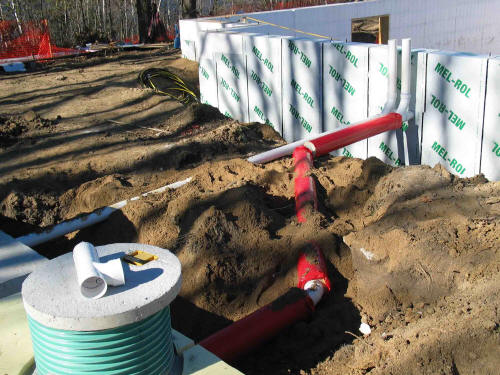
Here you see all six tanks, with 18,000 gallons total capacity. The building
foundation is in the background.
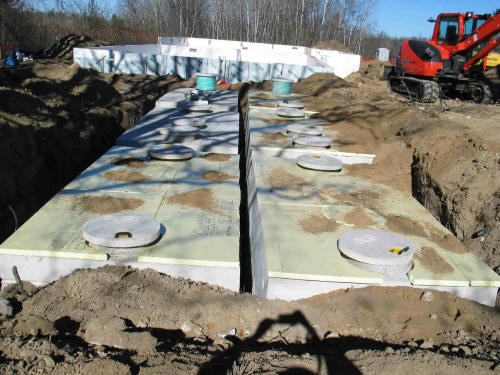
Here are the tanks from another perspective.
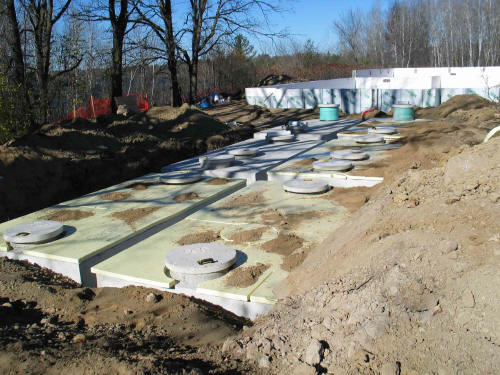
Here's a view, also on the 25th, of the building foundation, notable because
it is now in full view (with the lake in the distance), the huge piles of
"spoil" from the excavation having been trucked away, save for the spoil, on the
left, from the excavation for the septic tanks.
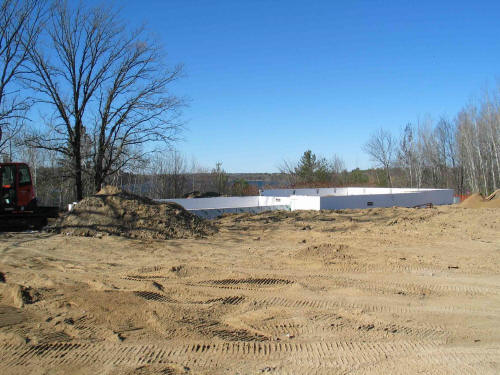
By that same day, the 25th, the basement floor had been poured. Here's a view
of floor following its sealing. That array of tubes sticking up in the center of
the photo is to be connected to the boilers that will provide heated liquid for
the in-floor heat in the basement.
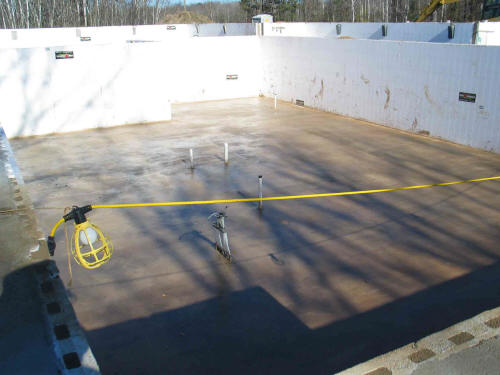
October 25: The septic drainfield is so vast that it's not possible to get a
single photo of all four mounds. Here's a view of the northwestern mound,
precisely and carefully graded, covered with black dirt, seeded, and strewn with
straw to prevent erosion and assist the seed to germinate, if not this fall,
then next spring.
NO HUNTING, ATV-ing or SNOWMOBILING on this property, which represents an
investment of some $100K.
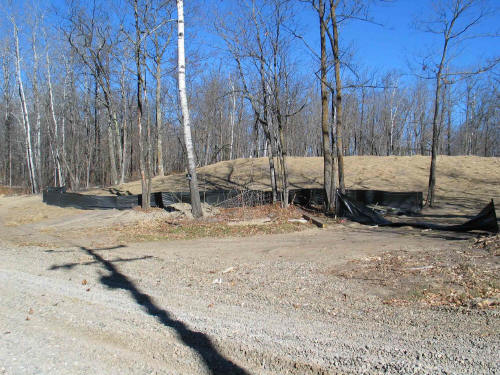
On Monday, October 27th, Ed Swanson trenched for the new water line from the
existing well to the building. Happily, the existing well is still good; the
Freemans have taken the pump out to refurbish it. The trench is about 10 feet
deep, to project from freezing, of course!
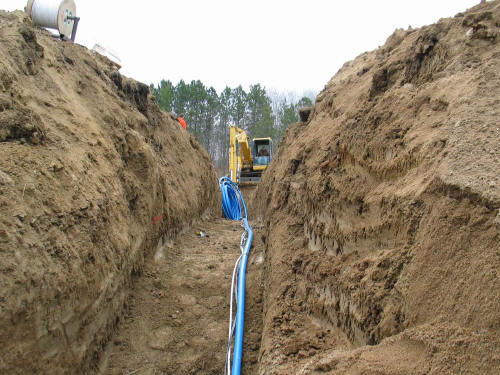
Matt Sutbine manhandles the line so as to bring it right up to the well,
where he will cut it to length and attach it. That's the electrical wire for
power to the pump lying along side the water line in this photo.
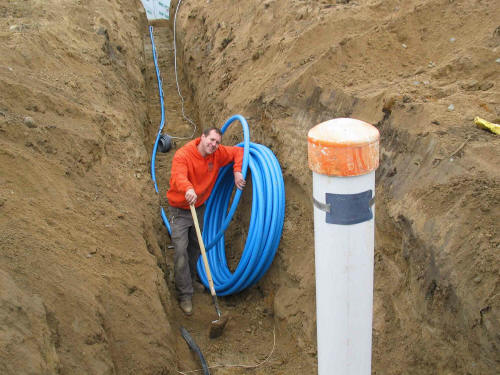
Also on the 27th, Jason Snodgrass and Luke Freeman run a PVC sleeve over the
water line and power cord. The sleeve will be slid back toward the building
where it will protect the waterline from compression under the area where the
driveway through the port cochere. The sleeve isn't needed the full length of
the distance from foundation to well.
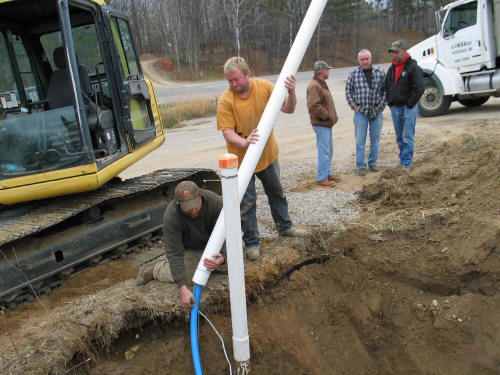
Here Matt Sutbine and Luke Freeman wait with shovels while Ed Swanson
backfills the trench with washed sand. Jason S. looks on from above. Those are
sheets of 2 in. styrofoam lying on the ground by Jason; they will be used to
insulate the water line before the trench is completely backfilled.
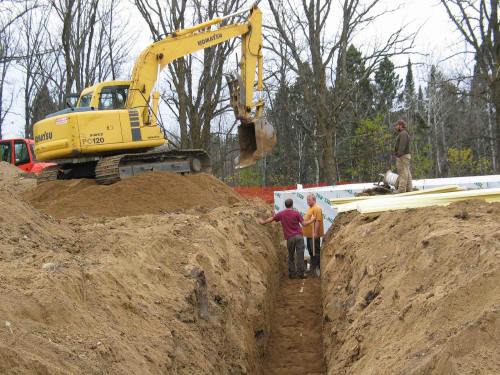
The next day, Tuesday the 28th, Jeremiah and Jack, of Rick Smith's crew, work
to install two pumps in the sixth of the 3,000 gallon tanks just outside the
south end of the building. From here the effluent will be pumped in doses into
the line leading out of this tank, across under the yard and under Long Bay Road
to the tanks in the parking lot. After processing there, the effluent will be
pumped under Highway 371 to the drainfield on the east side of the highway.
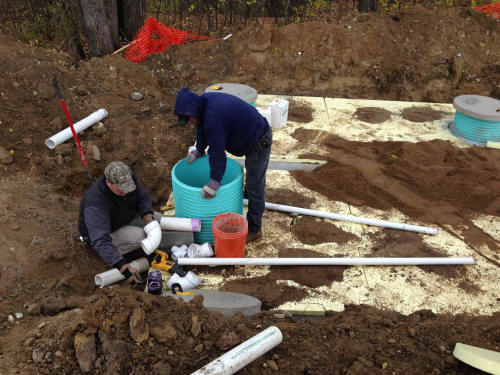
In the parking lot, there are two tanks existing, but a third must be added -
the "lift station" tank from which effluent will be pumped across the highway.
Here George Kobe completes the excavation which will allow this third tank to be
installed and connected to the existing, now central, tank.
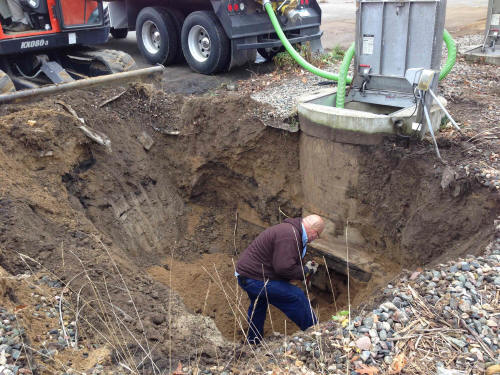
On Wednesday, the 29th, Jason and Kirk Lowe, our electric subcontractor,
discuss the placement of the electric lines, this one that will run out to the
existing light pole at the far northern end of the Arthur's lawn, and another
that will run out to the "front yard" and provide power to a lighted "Arthur's
Ten Mile Lake" sign.
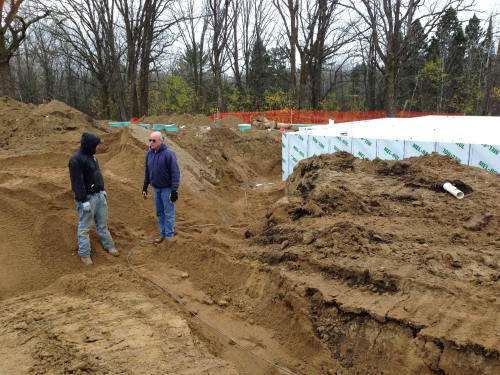
Further discussion of the electric line, by Jason and Kirk.
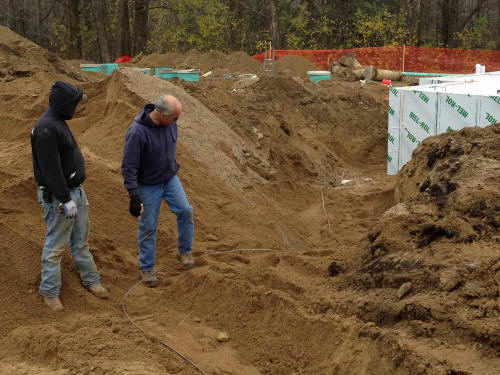
While the electric lines are being laid, Rick Smith and his crew are cleaning
out the existing large septic tank in the parking lot. A hole must be drilled in
this tank to connect it to the new tank adjacent to it, the "lift station" tank.
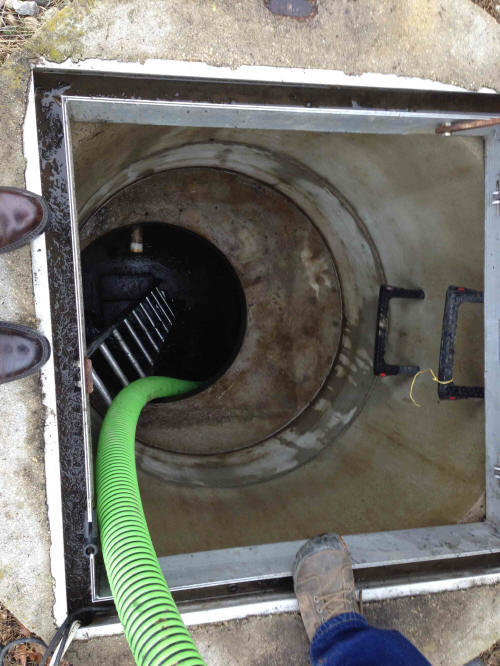
In place of the old, green-roofed gravel filter building in the parking lot,
Rick will install state-of-the-art technology which will clarify and purify the
effluent before it is pumped to the drain field. Here, on Thursday the 30th, is
the air pump that will provide a steady flow of air into the first
(southernmost) of three tanks in the parking lot. This tank is filled with
thousands of small, plastic cubes, a little like pasta noodles. The cubes are
kept in agitation by the air flow, and on the vast surface area that they
provide bacteria gather to eat and dispose of the solids that arrive in the
effluent from the building. The bacteria's excretions "after dinner" fall to the
bottom of the tank, which must be pumped regularly, while the clarified effluent
flows on through the central tank and into the "lift station" to be pumped
across the road.
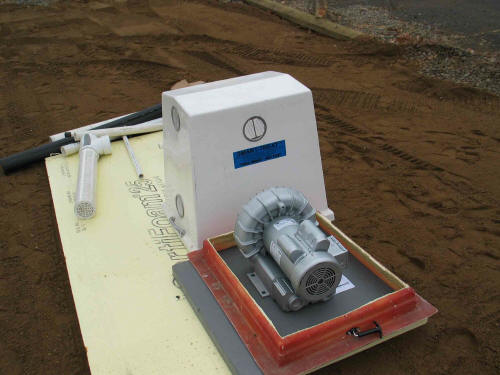
Here the air pump is enclosed in its case. You can see the pipe through which
air will flow into the southern most "digesting" tank.
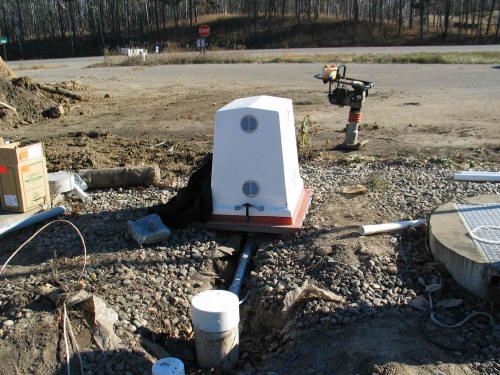
Saturday, November 1: Now, in lieu of the old green-roofed gravel filter,
this is all you will see in the parking lot. The controls for the pumps in the
tanks are mounted on the stand toward the right in the picture.
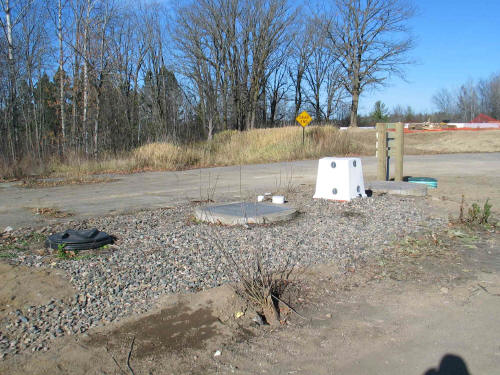
Saturday, November 1: The six-tank array at the south end of the foundation
has been backfilled, its controls mounted, and green covers placed on all but
two of the risers (more green covers are on order). This whole area will, of
course, be covered with black dirt and seeded; it should provide a pleasant
green lawn around these relatively unobtrusive riser tops come summer.

Nov. 1: The foundation under the screened porch must be filled with washed
sand and then packed to provide a firm foundation for the slab which will be
poured yet this fall. Here Jason is spreading sand; he will replace the Bob Cat
bucket with a vibrating packer to ensure that the sand won't yield after the
concrete floor is poured.
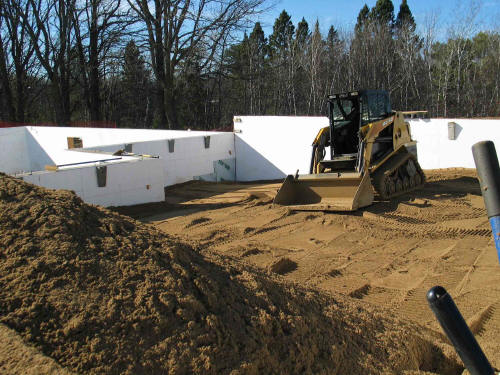
Nov. 1; Just a few of the many, many truckloads of sand being delivered to
the site to be used to fill the foundation of the screened porch, as well as to
backfill around the foundation of the main building. The clay on our site is the
"worst" Carl Peterson has ever seen; it holds on to water, and the freeze/thaw
cycle would cause it to expand and contract, and threaten the integrity of the
foundation. That is why the foundation must be backfilled with sand - which
won't hold water and will remain stable come what may, weather-wise.
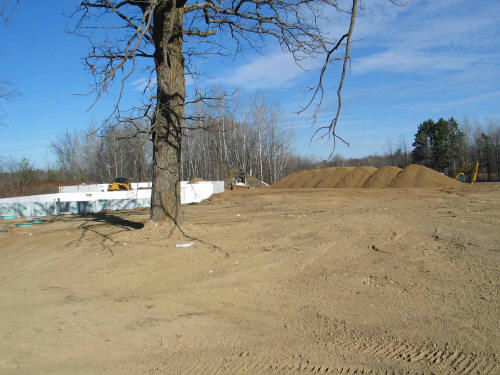
Monday, November 3: The plates go on the foundation in preparation for the
installation of the I-Joist floor trusses this week. That's the "packer"
attachment for the Bob Cat over in the far corner of the screen porch
foundation.
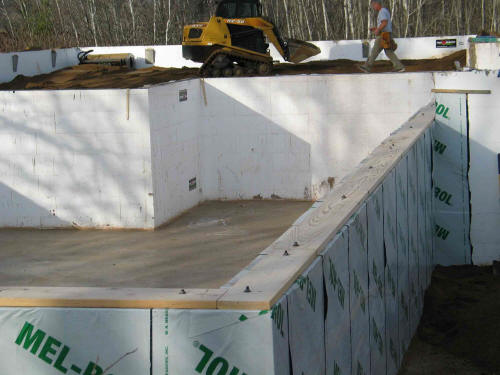
Here Carl measures for the Ice-Water and Still-Seal protectants that are
installed under the plates on the top of the foundation to keep water from
penetrating under or through the joint between the walls and the foundation.
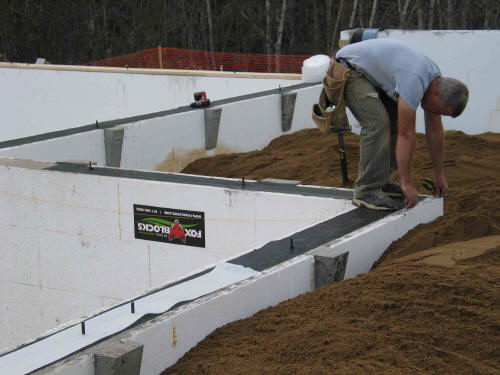
This week, on Tuesday November 4th, the I-Joists finally arrived from Canada
via Pillager. Here Caleb and his dad, Jerry Peterson, unwrap and prepare to trim
the joists prior to setting them on the foundation.
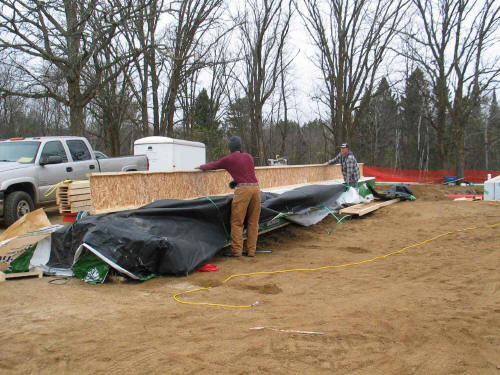
Here, on Wednesday the 5th, Jason and Caleb set one of the trusses and nail
it to the rim board.
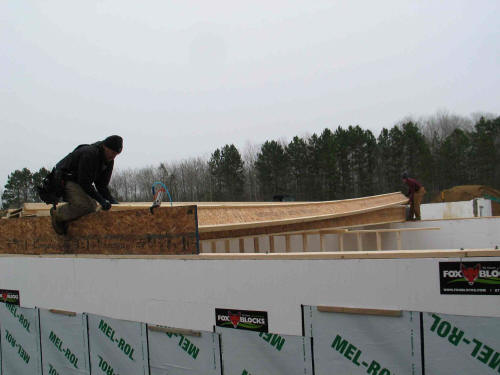
While the I-Joists are being set, Carl works on the bearing wall partition in
the basement. Here Jason and Caleb examine a air-driven nailing gun while Carl
nails the basement bathroom door frame into position.
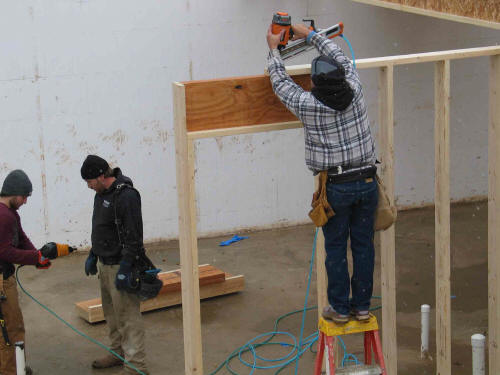
Here's that bearing wall partition, and the door frame Carl is nailing in
place in the previous picture.
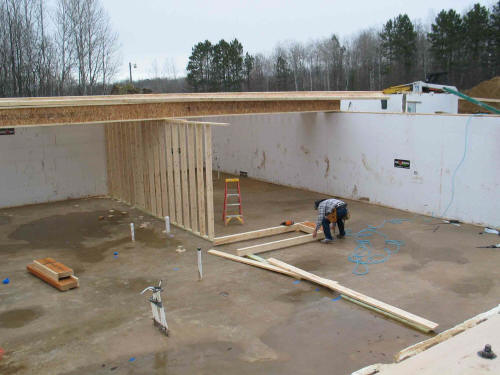
Nov. 5: A view of the bearing wall partition from "floor level."
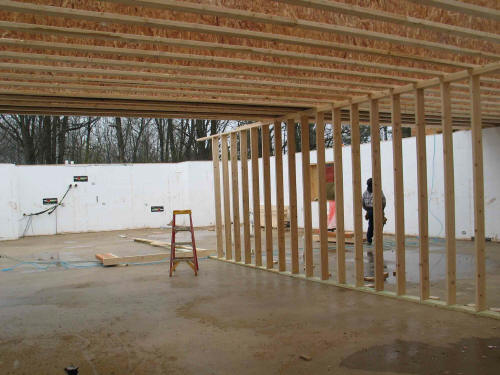
Wednesday the 5th started out pleasantly enough, but by mid-afternoon the
predicted snow had materialized. Here Jason taps the end of an I-Joist into
position before nailing it to the rim board. Yes, that's real snow falling
around him.
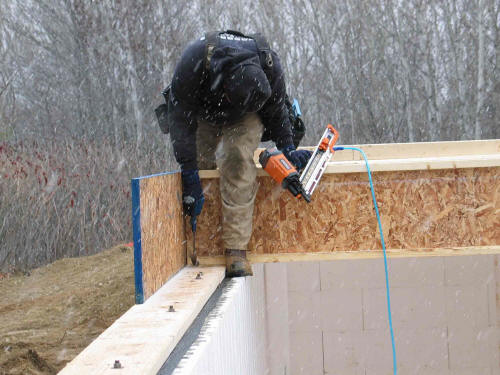
Wednesday afternoon in the snow, Caleb and Jerry Peterson and Ross Olsen move
another I-Joist Truss into position on the foundation.
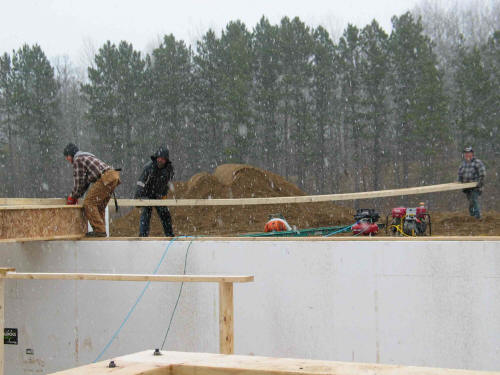
Nov. 5: Before the snow began to fall in earnest, Jason and Caleb maneuvered
another I-Joist into position.
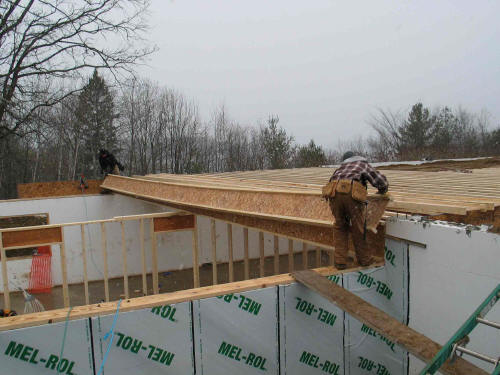
I'll be in Mpls. for the next five or six days, and won't be able to keep a
photo record of continuing progress. I'm expecting that Shari and Jerry Peterson
will be able to get some photos as the floor underlayment is laid and the walls
begin to go up, perhaps even as the porch floor is poured. I'll share those with
you, as well as other shots of progress, in another 10 days or so.













